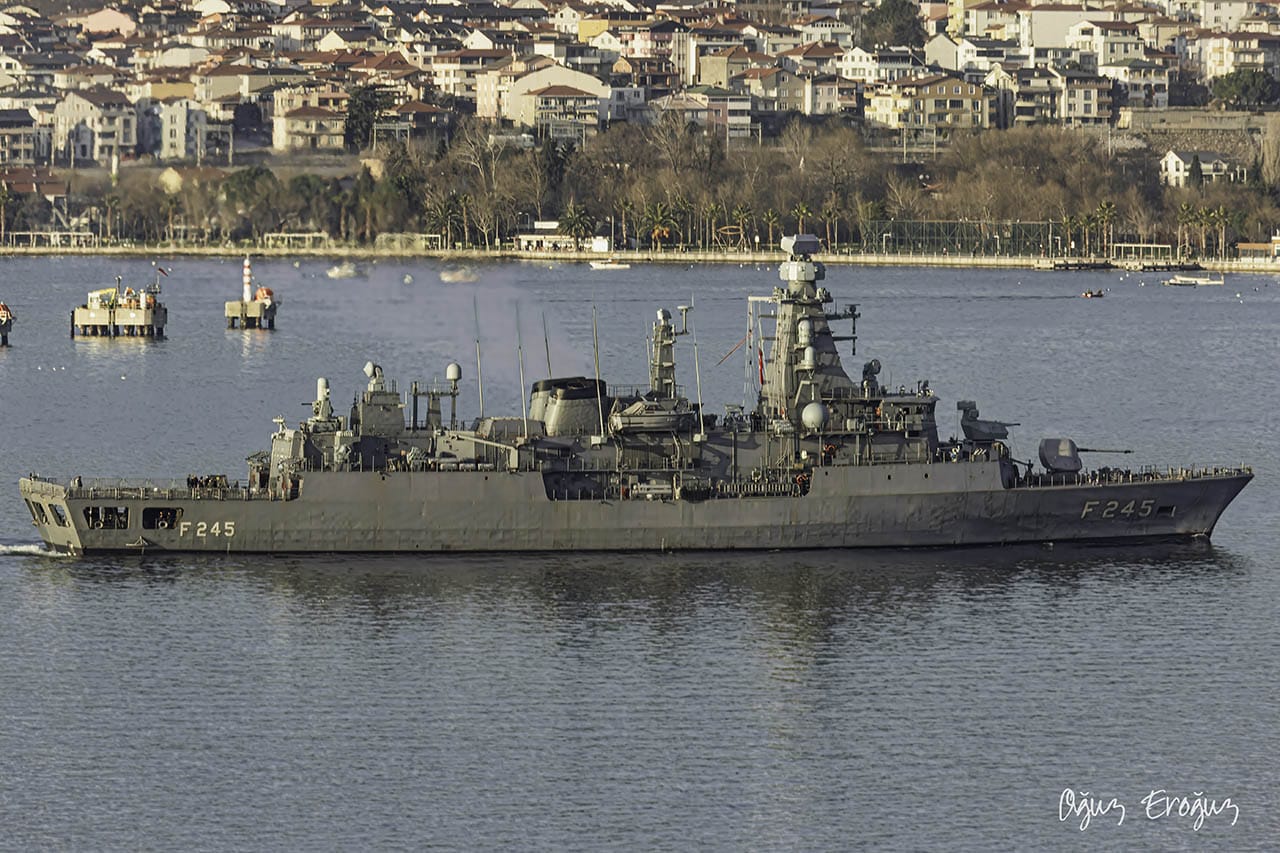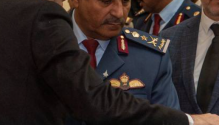@Stealthflanker Here's a recent, very informative thread from one of the most prominent Turkish journalists on MURAD GaN FCR and F-16 Özgür avionic mod. Wonder your thoughts about the given infos. It's unfortunately in Turkish but you should have no problem auto-translating it.
You are using an out of date browser. It may not display this or other websites correctly.
You should upgrade or use an alternative browser.
You should upgrade or use an alternative browser.
Turkey Military News, Reports, Data, etc.
- Thread starter Jeff Head
- Start date
RF Jammer
HEL - Optic Dazzler (10 kW)
35mm programmable airbust, tracking radar
VSHORAD (Sungur)
Alternative VSHORAD (Unnamed low-cost CLOS missile)
SHORAD (Bozdoğan YH renamed to be Göksur IIR - also indicates that there is Göksur RF)
Alternative SHORAD (Hisar family)
Also note;
Data link, for Goksur RF (Gokdogan YH) / Hisar RF and possibly for undisclosed CLOS missile.
---------
IVEWS for F-16Vs is confirmed
@Stealthflanker Here's a recent, very informative thread from one of the most prominent Turkish journalists on MURAD GaN FCR and F-16 Özgür avionic mod. Wonder your thoughts about the given infos. It's unfortunately in Turkish but you should have no problem auto-translating it.
AKINCI UCAV will make its first flight with MURAD AESA Radar in February!
Currently, integration studies are continuing on an AKINCI SİHA and one of the ÖZGÜR prototypes. First of all, it was integrated on AKINCI UCAV. Ground tests have been conducted and were recently completed. The first flight on AKINCI is expected to be made in February 2024. Within the scope of ground tests, the radar was first powered up and operated on the ground to test whether it could communicate bi-directionally with the Ground Control Station (YKİ) and whether it could transmit images. In this context, a software change was also made.
In addition, it was checked whether the 750hp capacity PT6A-135A Turboprop Engines on the AKINCI could meet the power needed for the MURAD AESA radar and it was seen that the need was met. However, it was evaluated that the capacity in question would not be sufficient for the UAV SOJ, and in this context, power increase work should be carried out on AKINCI.
It was stated that there is no difference in terms of capability between the AKINCI and F-16 ÖZGÜR versions of the MURAD AESA Fire Control Radar, but there are differences between the two versions due to power applications. MURAD is defined as an AESA radar that is open to development, multi-functional and not subject to any export restrictions thanks to its 'ITAR Free' feature.
The flight test campaign, which is planned to start in February 2024, is expected to last about 1 year. Recently, SSB and ASELSAN agreed on the supply of the radars needed within the scope of the ÖZGÜR II Project, which covers the MURAD AESA Radar Integration work on F-16C/D Block 30 Aircraft, which were modernized under the F-16 Block-30 National Mission Computer and Avionics Suite Development (ÖZGÜR) Project. An agreement had been signed. The AESA type nose/fire control radar (FCR), developed by ASELSAN for KAAN MMU/TF-X, will have 360-degree coverage capability, unlike MURAD.
MURAD AESA Radar
X-Band MURAD AESA Nose Radar, consisting of Transmission/Receiving and Signal Processing Unit (GASİB), Conversion Unit and Antenna sub-systems, was first introduced during the IDEF '21 Fair with its full scale model (mock-up). At the IDEF '23 Fair, the real LRU (Even Replaceable Unit) was used in the MURAD F-16 AESA Nose Radar mock-up, whose mechanical installation was made on a chassis manufactured in exactly the same dimensions as the real F-16 AN/APG-68(V)9 nose radar chassis. )'s were used, real LRUs were not included on the mock-up exhibited at the World Defense Show (WDS) 2024 Fair. While the upper shelf reserved for other equipment is empty, the lower shelf reserved for AESA electronic equipment is placed from back to front; There was a Heat Control Unit, Power Conversion Unit and Signal Processing Unit.
It was previously shared with the public that the 5mm x 5mm basic core chip used in the AESA Nose Radar is capable of transferring digital information at a speed of 500GB per second. In order for MURAD, which is a very powerful nose/fire control radar (FCR) with 1,152 Receive/Transmit (T/R) modules based on GaN technology, to show the desired performance, the cooling system must function successfully.
According to the information I obtained during the IDEF '19 Fair, the GaN-based Transmit/Receive (T/R) modules on the X-Band MURAD AESA Radar will operate with approximately 6.5kW power from the F-16. The peak power of the T/R modules, each with a capacity of 20W, will be 30W. Based on this information, the normal power value for the MURAD AESA Radar will be 23kW and the peak power value will be 34.5kW. In open sources, the normal power value for the APG-83 SABR AESA Nose/Fire Control Radar, consisting of The input power is 5.6kW, the peak power is 18kW (18.5kW for the [V]5 version), and the broadcast power is 600W. Another source gives the APG-68 radar as peak power of 17.5kW, beam width of 3.25 degrees sideways and 4.25 degrees of elevation, noise level of 3.25dB, weight of 172kg, power of 5.600VA (5.6KVA) and antenna diameter of 740mm x 480mm.
The F-16 version of MURAD is first tested on one of the Block-30 Aircraft that has undergone ÖZGÜR Avionics Modernization. In this context, integration studies have started and according to the Ministry of National Defense 2023 Corporate Financial Situation and Expectations Report, the first flight with the F-16 Block-30 ÖZGÜR Aircraft was planned to be carried out in September 2023. However, this schedule could not be met. The first flight on F-16 Block 30 is expected to take place in 2024.
ASELSAN General Manager Ahmet AKYOL, who made a statement about the MURAD Radar on September 1, within the scope of the TEKNOFEST Ankara event held in Ankara between August 30 and September 3, 2023, said, “Currently, its prototypes are being integrated into both our aircraft and UAVs, and the integration continues. "We will see UAVs and planes flying with this radar in our skies in the next few years," he said. MURAD AESA Nose/Fire Control Radar is also integrated on AKINCI SİHA. In this context, the first radar was delivered in the first half of 2023 to be tested on AKINCI. Haluk GÖRGÜN, who served as ASELSAN Chairman and General Manager at that time (he took over the Presidency of Defense Industries Presidency from İsmail DEMİR in June 2023), said in a statement he made in late May, “AESA Radar will be used first in AKINCI. The Radom arrived and we ran tests on it. We work hard with BAYKAR. We will start flight tests. "We produce our radar for several products at the same time," he said.
Thanks to MURAD AESA, F-16 Blok-30 ÖZGÜR Aircraft and AKINCI UCAVs will be able to use national air-air and air-ground/surface missiles at maximum range and effectiveness. Meanwhile, the F-16 Block-30 National Mission Computer and Avionics Suite, for which prototype applications were carried out on one single-seat F-16C and one double-seat F-16D Block-30 Aircraft, and the prototype aircraft were accepted in May 2023, following the completion of the qualification tests. In the Development (ÖZGÜR) Project, the protocol for the Mass Production Phase was signed by SSB and ASELSAN, TUSAŞ, TÜBİTAK SAGE, ROKETSAN and AFGM (1st HBFM) on July 26, 2023, during the IDEF '23 Fair.
from Ibrahim Sunnetci
@Deino @Stealthflanker et al.
So I was looking for a reason to procrastinate a bit, and found it in #3913 and ended up procrastinating too much. The linked article is a fairly interesting read in itself but what I found to be genuinely worth attention is how it lead me to re-evaluate my views on Turkish military stance and modernisation and pushed me into a rabbit hole of Turkish geopolitics and long-term strategy. Considering what this forum is and what kind of demographics it attracts I am not sure if it will be found of any interest to anyone, but I will share it in case someone wants a quick comprehensive primer. Definitely it will provide a much needed context to the content of this particular thread which is mostly curated in a style of industry PR with occasional pointless jingoism. With proper background however the information here can be very useful.
Thesis:
The program described in the article is too logical and too pragmatic to be incidental. But it doesn't match Turkey's political stances in recent years and rhetoric of reviving the Ottoman empire.
Proof:
Below is the material condition of the armed forces in 2024 which is 13 years into an ongoing conflict in Syria and ~25 years into post-Cold War modernisation effort.
----
Land Force
The numbers are approximated based on Wiki. Quantity in black, max range of arty in blue, technological age in red (obsolete) and green (modern).
MBT x2210
----
Navy
Numbers indicate age of individual primary combat vessels. Red indicates ships past 35 years of service. Green ships within standard lifespan. Purple is ships under construction. Ships listed by fist letter of class name i.e. "K" is Kılıç, "MG-A" is Milgem-Ada etc.
SSK x12
The navy lacks area defense and depends on air cover which limits its range of operations. This particularly puts into question the viability of Anadolu as Istanbul is not sufficient for high threat missions. No navy develops an aircraft carrier before area air defense. But if so Anadolu's intended area of operations must be somewhere under land-based air cover. Where?
----
Air Force
Combat aircraft: ~290
----
When we combine the three we have:
Unless you turn the map on the other side.
Obviously my assessment may be incorrect or flawed, but it largely fits what many other analysts have indicated so far with regards to Turkey's political ambition.
Thesis:
The program described in the article is too logical and too pragmatic to be incidental. But it doesn't match Turkey's political stances in recent years and rhetoric of reviving the Ottoman empire.
Proof:
Below is the material condition of the armed forces in 2024 which is 13 years into an ongoing conflict in Syria and ~25 years into post-Cold War modernisation effort.
----
Land Force
The numbers are approximated based on Wiki. Quantity in black, max range of arty in blue, technological age in red (obsolete) and green (modern).
MBT x2210
- Leopard 2 ~340
- Leopard 1 ~350
- M60 Sabra ~170
- M60A3 ~600
- M48A5 ~750
- ACV-15 ~2000
- M113 ~2800
- Kirpi/MRAP ~2400
- Cobra/IMV ~2000
- T122 90s/40k 120+
- TRG-300 00s/120k 54+
- M270 90s/165-300k 12+
- T155 00s/40k 280 +140
- M44/52 50s/25k 520
- M110 70s/30k 219
- M101 50s/11k 830
- M114 50s/15k 535
- M115 40s/23k 155
----
Navy
Numbers indicate age of individual primary combat vessels. Red indicates ships past 35 years of service. Green ships within standard lifespan. Purple is ships under construction. Ships listed by fist letter of class name i.e. "K" is Kılıç, "MG-A" is Milgem-Ada etc.
SSK x12
- 209 46 43 40 35
- 209T1 30 29 26 25
- 209T2 21 19 18 17
- 214 24 24 25 26 27 28
- OHP-G 44 43 43 43 43 43 42 41
- M200TN1-Y 37 36 36 35
- M200TN2-B 27 27 26 24
- MG-I 24 ?? ?? ??
- MG-A 13 11 6 5
- B 48 48 38 46 46 45
- K 26 25 24 19 19 17 17 15 14
- Y 27 27
- D 47 45 43
- R 38 37 37 36
The navy lacks area defense and depends on air cover which limits its range of operations. This particularly puts into question the viability of Anadolu as Istanbul is not sufficient for high threat missions. No navy develops an aircraft carrier before area air defense. But if so Anadolu's intended area of operations must be somewhere under land-based air cover. Where?
----
Air Force
Combat aircraft: ~290
- F-4E 48
- F-16C/D Bl.30/40/50/50+ 1987-2012 157/86
- F-16V 40 + 79 upg.
- Anka 0,35/1,3t 27
- Aksungur 0,75/3,3t 10
- Akinci 1,3/5,5t 14
- Kizilema 1,5/8,5t 2
----
When we combine the three we have:
- land forces - stagnation
- navy - struggling modernisation
- air force - modest, pragmatic update with intense effort to develop sovereign domestic solutions
Unless you turn the map on the other side.
Obviously my assessment may be incorrect or flawed, but it largely fits what many other analysts have indicated so far with regards to Turkey's political ambition.
Let's begin with analysis of Turkey's geopolitical constraints. Before we take a look at the map I need to make a disclaimer: in my analysis I omit Greece which in my view is only a convenient distraction and a plausible excuse to exercise force against other actors.
Greece is in NATO and EU therefore while a political conflict as means of exerting pressure on the EU is viable any armed conflict is completely impractical for Turkey even if it could achieve any constructive aims. The only such aim was takeover of northern Cyprus in 1974. Greece acceded to NATO along with Turkey in 1952 but to EEC only in 1981. The invasion aimed to prevent enosis i.e. annexation of Cyprus by Republic of Greece which would cordon off Turkey with Greek EEZ. Power projection in that area determined by Athens could have unintended escalatory consequences in case of any regional conflict involving Turkey but not Greece e.g. in Libya vs Egypt. Therefore I'm of the opinion that despite historical grievances the Cyprus conflict is purely a pragmatic issue imposed on Turkey by geography, and that if Cyprus was further to the west allowing Turkey's EEZ to connect with Syrian, Lebanese and Israeli EEZ Ankara wouldn't care about enosis because it's primary geopolitical interests lie in Asia and not Europe.
This is Turkey's topography:
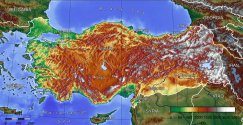
Note that Turkey can't be reliably threatened by land from the west due to dispersed landmass or from the west and Iraq due to mountainous terrain. Land invasion is viable only from Syria, which is why Turkey has established buffer zones there. As Syria is largely an arid/desert area it presents logistical complications to any potential invading force. It's not as easy to deploy and sustain any large mechanised formation in such conditions - not only for reasons of harsh climate, but also because such terrain is extremely vulnerable to air strikes and makes concealment difficult.
Therefore for purposes of territorial security neither effective land nor naval power is necessary. Objectively Turkey should emphasise offensive air power as primary defensive solution, similarly to how Israel shapes its defensive doctrine against external threats. And this is largely what we're seeing in the modernisation strategy: offensive air power is absolute priority, naval power is limited to necessary minimum required by three separate naval theaters (Black Sea, Aegean and Eastern Med) and land power only receives what is left since the army serves primarily as internal deterrent against coups and instability.
With ~300 multirole aircraft Turkey is capable of credibly deterring all plausible threats of invasion of territory regardless of the material quality of its naval and land forces. Therefore it can afford to neglect its material condition as long as personnel loyalty is secured which involves primarily material and social conditions of cadres and, to lesser extent, conscripts. It also explains why the 2016 purge focused so extensively on the air force. As long as the air force is effective Turkey is secure which mirrors the approach of Sweden during the Cold War.
So how does that fit into Turkey's current political ambitions? Turkey clearly is interested in expanding its influence and not just securing its territory.
----
Let's look at a map of Turkey's geopolitical constraints: land borders in red, sea borders (coast) in blue, power projection zones in brown, main geopolitical rivals in orange, except Russia which is in purple with power projection zones in pink and allied states in green
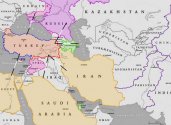
The black-white-black bars denote a (very) approximate 600km radius i.e. ~50% F-16 internal fuel.
There are two areas of competition:
main geopolitical actors in theater
In the near term the most impactful direction is Caucasus.
----
Meghri municipality in Armenia, bordering Iran, has population of only 11k. Bordering it are municipalities: Kapan, with population of only 6,5k outside of town of Kapan (43k) and Kajaran, with 9k total of which 7k in town of Kajaran.
Capture of Zangezur corridor is an obvious strategic aim for both Turkey and Azerbaijan as it would establish a continous territorial link from Turkey to the Caspian Sea which would allow Turkey to extend its power projection directly to Central Asia. It would also resolve the issue of pipelines having to go through Georgia. Therefore I suspect the issue will be forced as soon as the ongoing expulsion of Armenian population from Nagorno-Karabakh is completed.
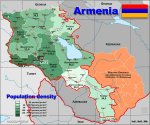
If Armenia reacts it may provide justification to occupation of territory of municipalities Suynik (142k) and Vayots Dzor (53k) which both account for only 6,5% of Armenia's population but also include key economic assets like the Kajaran mine. Since minrerals account for 32% of Armenian exports Armenia will likely relinquish territorial control to the corridor if pressed militarily. Russia will not intervene as demonstrated by the recent crisis for as long as it is focused on Ukraine.
Iran naturally will be opposed to this development however the extent of Azeri population in northern Iran (15+%) may prevent any direct intervention as Iran will try to avoid escalating the threat of internal instability, especially that for weakening Iran Turkey would have silent support from both US and EU but at the same time the creation of Zangezur corridor is opposed by both. However it is unlikely that this will translate to any meaningful resistance if the situation if resolved by force, provided that it is contained and only extends to establishing a land corridor of acceptable size.
Creating direct land route to Azerbaijan would physically enable Turkey to project power into Central Asia.
Greece is in NATO and EU therefore while a political conflict as means of exerting pressure on the EU is viable any armed conflict is completely impractical for Turkey even if it could achieve any constructive aims. The only such aim was takeover of northern Cyprus in 1974. Greece acceded to NATO along with Turkey in 1952 but to EEC only in 1981. The invasion aimed to prevent enosis i.e. annexation of Cyprus by Republic of Greece which would cordon off Turkey with Greek EEZ. Power projection in that area determined by Athens could have unintended escalatory consequences in case of any regional conflict involving Turkey but not Greece e.g. in Libya vs Egypt. Therefore I'm of the opinion that despite historical grievances the Cyprus conflict is purely a pragmatic issue imposed on Turkey by geography, and that if Cyprus was further to the west allowing Turkey's EEZ to connect with Syrian, Lebanese and Israeli EEZ Ankara wouldn't care about enosis because it's primary geopolitical interests lie in Asia and not Europe.
This is Turkey's topography:

Note that Turkey can't be reliably threatened by land from the west due to dispersed landmass or from the west and Iraq due to mountainous terrain. Land invasion is viable only from Syria, which is why Turkey has established buffer zones there. As Syria is largely an arid/desert area it presents logistical complications to any potential invading force. It's not as easy to deploy and sustain any large mechanised formation in such conditions - not only for reasons of harsh climate, but also because such terrain is extremely vulnerable to air strikes and makes concealment difficult.
Therefore for purposes of territorial security neither effective land nor naval power is necessary. Objectively Turkey should emphasise offensive air power as primary defensive solution, similarly to how Israel shapes its defensive doctrine against external threats. And this is largely what we're seeing in the modernisation strategy: offensive air power is absolute priority, naval power is limited to necessary minimum required by three separate naval theaters (Black Sea, Aegean and Eastern Med) and land power only receives what is left since the army serves primarily as internal deterrent against coups and instability.
With ~300 multirole aircraft Turkey is capable of credibly deterring all plausible threats of invasion of territory regardless of the material quality of its naval and land forces. Therefore it can afford to neglect its material condition as long as personnel loyalty is secured which involves primarily material and social conditions of cadres and, to lesser extent, conscripts. It also explains why the 2016 purge focused so extensively on the air force. As long as the air force is effective Turkey is secure which mirrors the approach of Sweden during the Cold War.
So how does that fit into Turkey's current political ambitions? Turkey clearly is interested in expanding its influence and not just securing its territory.
----
Let's look at a map of Turkey's geopolitical constraints: land borders in red, sea borders (coast) in blue, power projection zones in brown, main geopolitical rivals in orange, except Russia which is in purple with power projection zones in pink and allied states in green

The black-white-black bars denote a (very) approximate 600km radius i.e. ~50% F-16 internal fuel.
There are two areas of competition:
- immediate contested area including countries bordering Turkey in the Caucasus and the Middle East.
- extended contested area including Central Asian (Turkic) states and coastal areas of the eastern Med, Red Sea, Gulf of Aden (not shown), Arabian Sea and Persian Gulf
main geopolitical actors in theater
- TUR 82 (20% Kurdish) / 89 (+8%)
- RUS 146 / 132 (-10%)
- IRN 86 (15% Azeri, 10-15% Kurdish) / 101 (+18%)
- EGY 100 /138 (+38%)
- SAU 30 / 40 (+33%)
- IRQ 42 (10-15% Kurdish) / 76 (+81%)
- SYR 22 (10% Kurdish) / 31 (+41%)
- GRG 5 / 5
- ARM 3 / 2,5
- AZB 10 / 11
- KAZ 19 / 22
- UZB 30 / 35
- TKM 6 / 7
- KRG 6 / 7
- TJK 9 / 12
- AFG 37 / 64 (+73%)
- YEM 30 / 46 (+53%)
In the near term the most impactful direction is Caucasus.
----
Meghri municipality in Armenia, bordering Iran, has population of only 11k. Bordering it are municipalities: Kapan, with population of only 6,5k outside of town of Kapan (43k) and Kajaran, with 9k total of which 7k in town of Kajaran.
Capture of Zangezur corridor is an obvious strategic aim for both Turkey and Azerbaijan as it would establish a continous territorial link from Turkey to the Caspian Sea which would allow Turkey to extend its power projection directly to Central Asia. It would also resolve the issue of pipelines having to go through Georgia. Therefore I suspect the issue will be forced as soon as the ongoing expulsion of Armenian population from Nagorno-Karabakh is completed.

If Armenia reacts it may provide justification to occupation of territory of municipalities Suynik (142k) and Vayots Dzor (53k) which both account for only 6,5% of Armenia's population but also include key economic assets like the Kajaran mine. Since minrerals account for 32% of Armenian exports Armenia will likely relinquish territorial control to the corridor if pressed militarily. Russia will not intervene as demonstrated by the recent crisis for as long as it is focused on Ukraine.
Iran naturally will be opposed to this development however the extent of Azeri population in northern Iran (15+%) may prevent any direct intervention as Iran will try to avoid escalating the threat of internal instability, especially that for weakening Iran Turkey would have silent support from both US and EU but at the same time the creation of Zangezur corridor is opposed by both. However it is unlikely that this will translate to any meaningful resistance if the situation if resolved by force, provided that it is contained and only extends to establishing a land corridor of acceptable size.
Creating direct land route to Azerbaijan would physically enable Turkey to project power into Central Asia.
Despite failure to modernize the land forces Turkey uses its arms industry to extend influence in the domain that produces indirect results. Recent efforts to gain contracts in Kazakhstan along contracts in Uzbekistan and Turkmenistan effectively put "Turkish arms" on the other side of Caspian Sea even though they are manned by non-Turkish (but Turkic) personnel.
Weapons are followed by sustainment and training which can, and often is, followed by opening of infrastructure. That easily leads to military deployment.
Kazahstan is crucial because it will provide a necessary territorial buffer for Turkmenistan and Uzbekistan which are not members of CTSO ( Uzbekistan since 2012, Turkmeninstan never joined). While both Armenia and Kazakhstan remain members of CSTO it is evident that they are pursuing gradual withdrawal as permitted by political circumstances. Any direct link between Turkey and Azerbaijan proper would provide additional motivation as Turkey could provide security to Kazakhstan through indirect means by forcing Russia to expend resources in Syria and Armenia and at the same time direct land route provides economic incentive for energy exports. With Kazakhstan serving as buffer Turkey can deploy assets to Turkmenistan and Uzbekistan.
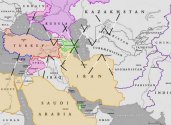
Again the focus on the aerial branch yields best results as the most efficient way to project power and influence in the region is through air power and enhancing of information domain. In short Turkey can say "you provide the army and we will provide the air force" which will be the most optimal solution since Central Asian states have small and obsolete air forces using Su-27, MiG-29s and Su-25s while their ground forces are technologically comparable with Russian ground force potential. Similarly Iran will be most easily deterred by deployment of air assets.
This likely provides the best justification for Turkey's pursuit of autonomy and independence in aerial domain, especially Kaan, high payload drones, domestic AESA radars and missiles as only with sovereign capabilities - independent of US, China, Russia or the EU - can Turkey employ this strategy effectively since all these four actors will be competing in the region and will restrict Turkey's options.
In the meantime however even F-16V or equivalent can be of use against Su-35S/30SM2 or Su-34M. Only Su-57 will be problematic, but Russia will need them to counter growing numbers of F-35 in neighbouring NATO countries: 165 by ~2030 shared between Norway, Finland, Denmark and Poland.
----
A very likely long-term fallout of the Russo-Ukrainian war may be reignition of separatism in the Caucasus.
These seven ethnic republics with combined population of 7,5 million - of which approx 0,6m Russians - have combined economy of less than 20bn EUR (2021). It will be trivial to contribute funds necessary as economic rationale for separation since the political and cultural already exist.
With those republics separated from Russian Federation only Astrakhan Oblast (49k km2, 960k pop. 57% Russian) will provide access to Caspian Sea.
As long as territorial issues in Ukraine remain unresolved and Russia is forced to commit military assets to securing territory it remains incapable of effectively countering any organised separatist effort. Those efforts will emerge as soon as a non-Russian power projection is logistically sustainable in the theater. Considering the mountainous terrain deployment of heavy forces will be constrained and air power will be crucial to protect logistics supporting the separatist forces.
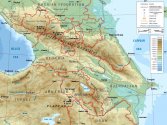
Another crucial factor is water - Middle East is one of the most water-stressed regions of the world while Caucasus has very high levels of water per capita, allowing them to trade the excess across the region.
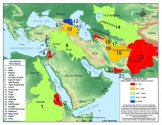
Turkey's ability to project power independently of US/EU will also allow it to extend - if necessary or useful - guarantees of protection for the current independent status of South Ossetia and Abkhazia. These can prove crucial to supporting energy infrastructure across Zangezur corridor and would allow to directly influence Georgia's position vs EU and NATO. With the separation of Caucasus republics from Russia, membership in NATO and EU may be no longer seen as crucial to Georgia's security which will allow Turkey to influence attitudes of various political groups in Georgia.
All of the above relies on Turkey's ability to project air and information power across the theater. It will be obviously much more viable with Kaan & Kizilema and other new technologies but even with upgraded F-16s Turkey will have a number of options against a deeply weakened Russia considering that Russia would be forced to project power offensively.
What becomes especially interesting is the possibility to transfer "woefully obsolete" equipment to newly formed separatist forces which can thus be sustained at low cost in materiel and training provided by Turkish Land Forces. Hundreds of tanks and personnel carriers as well as artillery can be made available without significant reduction to TAF capabilities. The force doesn't need to be large, it only needs to be large enough for Russia to find itself incapable of redirecting proportionally larger amount of woefully obsolete equipment from their reserve stocks which are running low due to the ongoing war in Ukraine.
----
And that all ties in to something I've touched upon:
Russia and its sphere of influence is an artificial creation sustained by force alone. As soon as that force is invalidated the creation must dissolve but it will happen at its own pace because nobody likes big things suddenly falling on their head. But if I can see the connections with such limited effort, people who have a vested interest have seen and acted on it. We may be simply seeing the signs of things changing. And I would expect that of all the countries Turkey is most interested in causing said change to happen faster (or at all) simply because unlike primary geopolitical actors (US, China, EU) Turkey can't rely on natural advantages of resource base and economic potential to achieve its goals. Moreover all three primary actors have an interest in preserving Russia as a political entity for their own purposes and will only push for deconstruction if rivals gain control over Russia.
In contrast Turkey can achieve its aims only through decontruction of Russian sphere of influence and parts of Russian state beacuse otherwise it risks allowing primary actors to gain influence through the Russian state used instrumentally. Turkey benefits most from that deconstruction and will largely avoid any direct fallout. Collapse of Russia will scattershot the periphery i.e. Europe in the west, China in the east and the US in the west, east and north. But Central Asia is a "dead" zone for primary powers so Turkey can consistently prod right into the very geographical center of Russia at relatively low cost with a relatively high payout for a country of Turkey's potential. A culturally-aligned sphere of influence with population equal to Turkey's, natural resources and geographic position to contain a rival neighbour?
All that at the cost of no costly expasion of ground forces or navy and instead technological modernisation of existing air force structures - by updating manned aircraft, expanding unmanned fleet and modernising ground-based air defenses with domestic solutions (S-400 sale may yet return to haunt Russia).
Central Asia is a steppe. It is home for the fast, mobile and ranged horse archer but the horse archer of today is the aircraft. Normally I would point to helicopters first but in Central Asia distances are too great even for tiltrotors to play that role reliably and logistical burden makes rotorcraft vulnerable to longer-ranged jets. Caucasus and other mountains also benefit from aerial presence. What is needed is bases and bases require people. Turkey seems to have the right tool to get them to their side it seems.
This strategy is exceedingly ambitious in geopolitical sense and so I am forced to stop the thought experiment and return to a position of skepticism. Still... it seems too logical.
What do you think?
----
I did not expect the rabbit hole to be this deep but it was an interesting tumble. And now I'm through and out. Hopefully I did not bore anyone too much and this lengthy essay will be helpful some day.
Weapons are followed by sustainment and training which can, and often is, followed by opening of infrastructure. That easily leads to military deployment.
Kazahstan is crucial because it will provide a necessary territorial buffer for Turkmenistan and Uzbekistan which are not members of CTSO ( Uzbekistan since 2012, Turkmeninstan never joined). While both Armenia and Kazakhstan remain members of CSTO it is evident that they are pursuing gradual withdrawal as permitted by political circumstances. Any direct link between Turkey and Azerbaijan proper would provide additional motivation as Turkey could provide security to Kazakhstan through indirect means by forcing Russia to expend resources in Syria and Armenia and at the same time direct land route provides economic incentive for energy exports. With Kazakhstan serving as buffer Turkey can deploy assets to Turkmenistan and Uzbekistan.

Again the focus on the aerial branch yields best results as the most efficient way to project power and influence in the region is through air power and enhancing of information domain. In short Turkey can say "you provide the army and we will provide the air force" which will be the most optimal solution since Central Asian states have small and obsolete air forces using Su-27, MiG-29s and Su-25s while their ground forces are technologically comparable with Russian ground force potential. Similarly Iran will be most easily deterred by deployment of air assets.
This likely provides the best justification for Turkey's pursuit of autonomy and independence in aerial domain, especially Kaan, high payload drones, domestic AESA radars and missiles as only with sovereign capabilities - independent of US, China, Russia or the EU - can Turkey employ this strategy effectively since all these four actors will be competing in the region and will restrict Turkey's options.
In the meantime however even F-16V or equivalent can be of use against Su-35S/30SM2 or Su-34M. Only Su-57 will be problematic, but Russia will need them to counter growing numbers of F-35 in neighbouring NATO countries: 165 by ~2030 shared between Norway, Finland, Denmark and Poland.
----
A very likely long-term fallout of the Russo-Ukrainian war may be reignition of separatism in the Caucasus.
| republic | population | Russians | ~GRP (bn. EUR 2021) | ~GDP p.c. (EUR 2021) |
| Kalmykia | 267k | 25,7% | 1 | 4000 |
| Dagestan | 3187k | 3,3% | 9 | 3000 |
| Chechnya | 1510k | 1,2% | 3 | 2000 |
| Ingushetia | 509k | 0,7% | 1 | 2000 |
| North Ossetia-Alania | 687k | 18,9% | 2 | 3000 |
| Kabardino-Balkaria | 904k | 19,8% | 2 | 3000 |
| Karchay-Cherkassia | 470k | 27,5% | 1 | 3000 |
These seven ethnic republics with combined population of 7,5 million - of which approx 0,6m Russians - have combined economy of less than 20bn EUR (2021). It will be trivial to contribute funds necessary as economic rationale for separation since the political and cultural already exist.
With those republics separated from Russian Federation only Astrakhan Oblast (49k km2, 960k pop. 57% Russian) will provide access to Caspian Sea.
As long as territorial issues in Ukraine remain unresolved and Russia is forced to commit military assets to securing territory it remains incapable of effectively countering any organised separatist effort. Those efforts will emerge as soon as a non-Russian power projection is logistically sustainable in the theater. Considering the mountainous terrain deployment of heavy forces will be constrained and air power will be crucial to protect logistics supporting the separatist forces.

Another crucial factor is water - Middle East is one of the most water-stressed regions of the world while Caucasus has very high levels of water per capita, allowing them to trade the excess across the region.

Turkey's ability to project power independently of US/EU will also allow it to extend - if necessary or useful - guarantees of protection for the current independent status of South Ossetia and Abkhazia. These can prove crucial to supporting energy infrastructure across Zangezur corridor and would allow to directly influence Georgia's position vs EU and NATO. With the separation of Caucasus republics from Russia, membership in NATO and EU may be no longer seen as crucial to Georgia's security which will allow Turkey to influence attitudes of various political groups in Georgia.
All of the above relies on Turkey's ability to project air and information power across the theater. It will be obviously much more viable with Kaan & Kizilema and other new technologies but even with upgraded F-16s Turkey will have a number of options against a deeply weakened Russia considering that Russia would be forced to project power offensively.
What becomes especially interesting is the possibility to transfer "woefully obsolete" equipment to newly formed separatist forces which can thus be sustained at low cost in materiel and training provided by Turkish Land Forces. Hundreds of tanks and personnel carriers as well as artillery can be made available without significant reduction to TAF capabilities. The force doesn't need to be large, it only needs to be large enough for Russia to find itself incapable of redirecting proportionally larger amount of woefully obsolete equipment from their reserve stocks which are running low due to the ongoing war in Ukraine.
----
And that all ties in to something I've touched upon:
PLA Strike Strategies in Westpac HIC
I am not sure China wants to start AR according to America’s timetable just to relieve pressure on the Russians. That would be a total inversion of China’s priorities. Indeed, China may well see an Europe theatre as a prime opportunity to bleed the US and force it to shift forces and resource...
www.sinodefenceforum.com
PLA Strike Strategies in Westpac HIC
That's not my argument. Read again 2nd to 5th paragraph but not as separate statements but as single continuous line of reasoning. It's the problem of troop morale like when you order an infantry charge at enemy positions defended by artillery but have no artillery of your own. The...
www.sinodefenceforum.com
Russia and its sphere of influence is an artificial creation sustained by force alone. As soon as that force is invalidated the creation must dissolve but it will happen at its own pace because nobody likes big things suddenly falling on their head. But if I can see the connections with such limited effort, people who have a vested interest have seen and acted on it. We may be simply seeing the signs of things changing. And I would expect that of all the countries Turkey is most interested in causing said change to happen faster (or at all) simply because unlike primary geopolitical actors (US, China, EU) Turkey can't rely on natural advantages of resource base and economic potential to achieve its goals. Moreover all three primary actors have an interest in preserving Russia as a political entity for their own purposes and will only push for deconstruction if rivals gain control over Russia.
In contrast Turkey can achieve its aims only through decontruction of Russian sphere of influence and parts of Russian state beacuse otherwise it risks allowing primary actors to gain influence through the Russian state used instrumentally. Turkey benefits most from that deconstruction and will largely avoid any direct fallout. Collapse of Russia will scattershot the periphery i.e. Europe in the west, China in the east and the US in the west, east and north. But Central Asia is a "dead" zone for primary powers so Turkey can consistently prod right into the very geographical center of Russia at relatively low cost with a relatively high payout for a country of Turkey's potential. A culturally-aligned sphere of influence with population equal to Turkey's, natural resources and geographic position to contain a rival neighbour?
All that at the cost of no costly expasion of ground forces or navy and instead technological modernisation of existing air force structures - by updating manned aircraft, expanding unmanned fleet and modernising ground-based air defenses with domestic solutions (S-400 sale may yet return to haunt Russia).
Central Asia is a steppe. It is home for the fast, mobile and ranged horse archer but the horse archer of today is the aircraft. Normally I would point to helicopters first but in Central Asia distances are too great even for tiltrotors to play that role reliably and logistical burden makes rotorcraft vulnerable to longer-ranged jets. Caucasus and other mountains also benefit from aerial presence. What is needed is bases and bases require people. Turkey seems to have the right tool to get them to their side it seems.
This strategy is exceedingly ambitious in geopolitical sense and so I am forced to stop the thought experiment and return to a position of skepticism. Still... it seems too logical.
What do you think?
----
I did not expect the rabbit hole to be this deep but it was an interesting tumble. And now I'm through and out. Hopefully I did not bore anyone too much and this lengthy essay will be helpful some day.
@MarKoz81 first of all, thank you for your effort on brainstorming. I haven't read everything you've written, just some of it, but here are my basic thoughts:
1. Turkey is not trying to revive the O.E. (no matter the internal propaganda of the ruling party members); it is simply trying to keep the threats away as any state in this dangerous geograpy would try to do (they're doing a poor job)
2. Engines are the only major bottleneck right now, Turkish jet aircraft, including Kaan, Hurjet and the jet UCAVs/LW use either American or Ukr engines. While Turkey has no problems getting the marine engines it needs, there's always a looming htreat of embargo from its allies.
3. Yes, major surface fleets are a bit old but the speed of large corvette/frigate constuction has increased tremendously in the last two years compared to before. Barbaros class are also undergoing MLU at the same time.
(and T214TNs are quite new, even the lead ship hasn't entered service yet and 3,4 and 5th boats are all in various stages of construction afaik)
4. Yes, the Army lacks modern armor in large quantities, however there are various modernization efforts underway, it was just yesterday when the first tank of a major indigenous M-60T(M) mod was delivered. Leo 2s are also undergoing a similar upgrade package and currently there are even trials of two different M-60A3 mods. Altay needs to be serially produced ASAP but even the new factory is not quite ready yet.
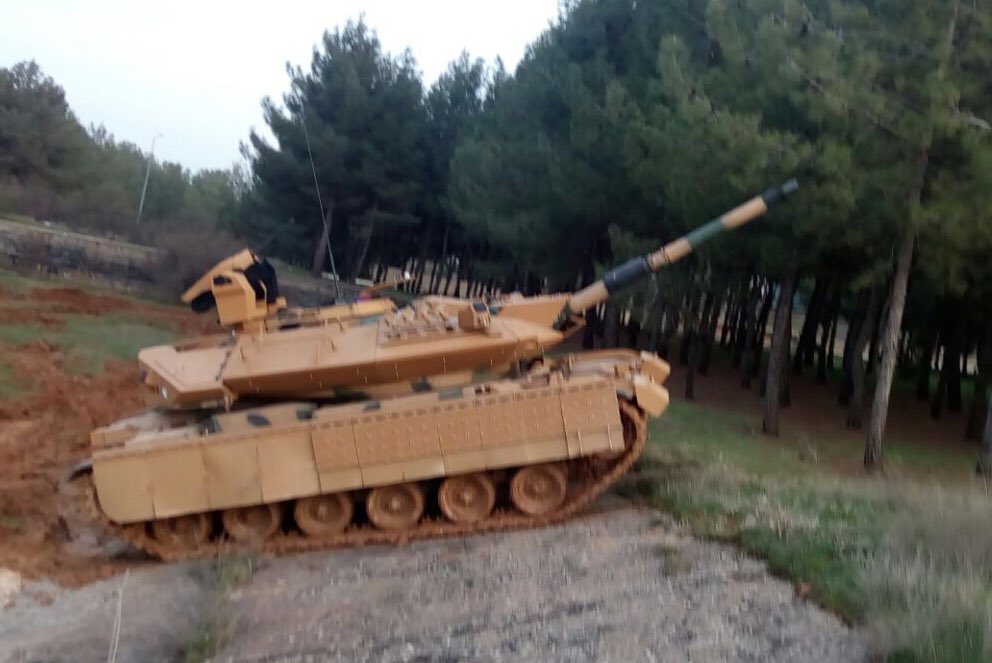

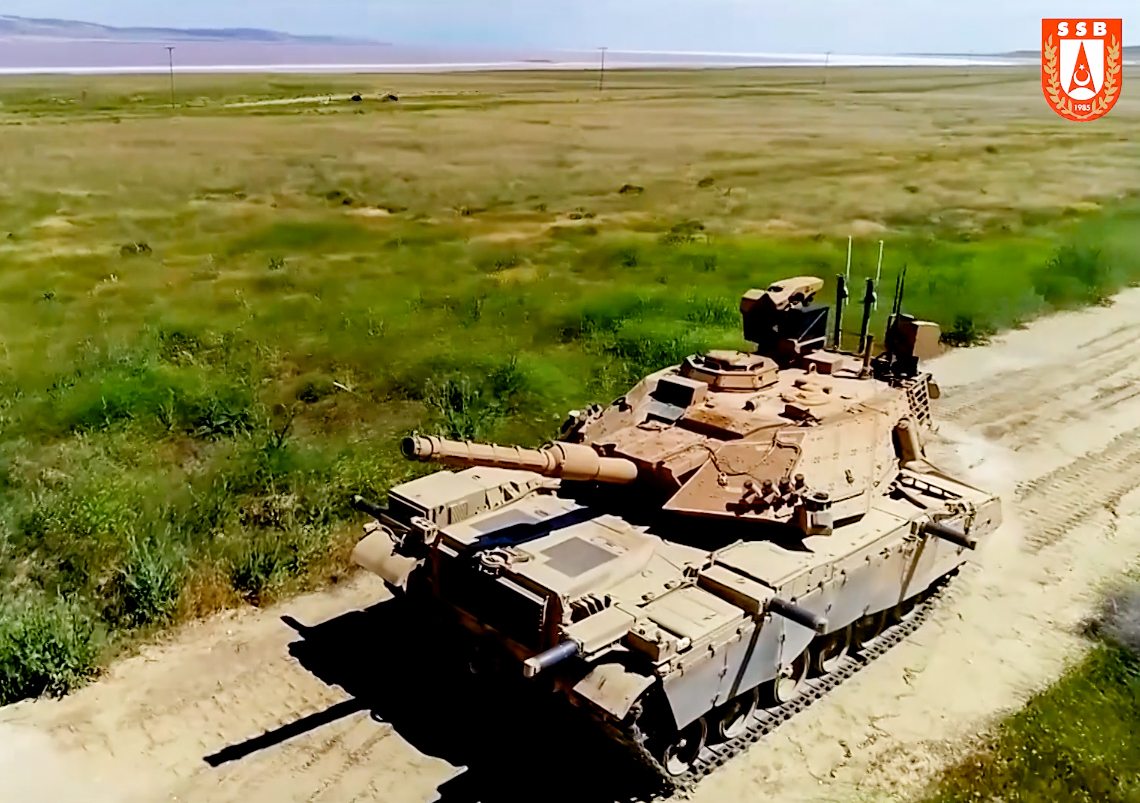
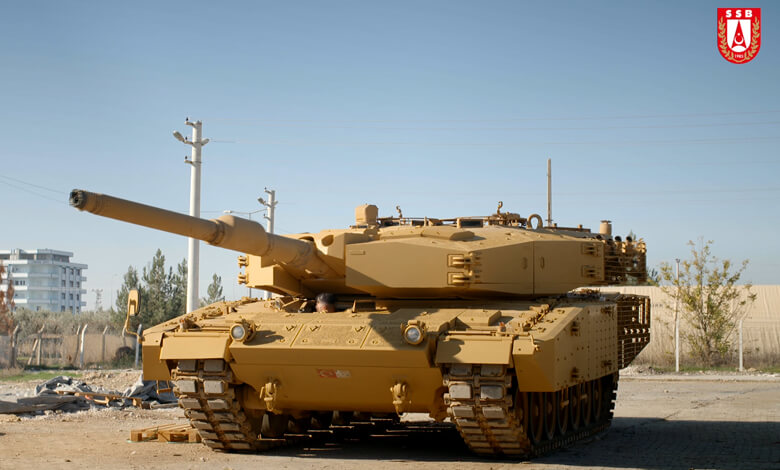
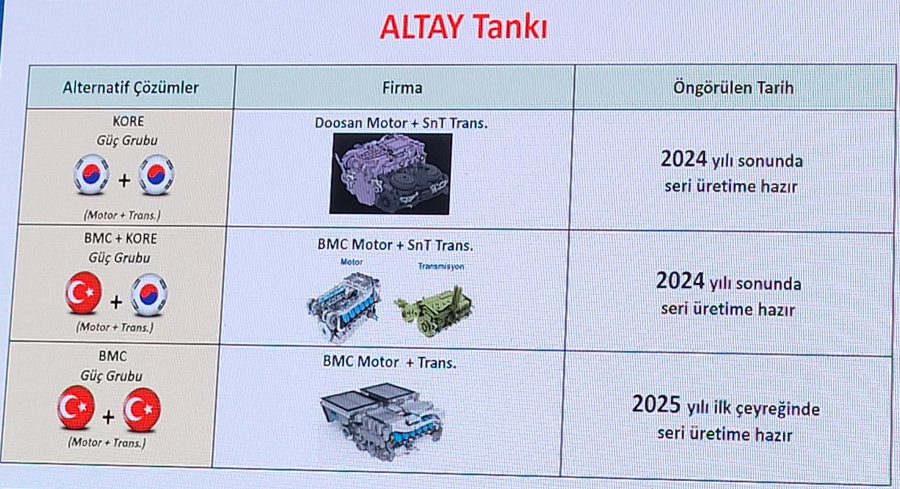
There are two very large APC and IFV procurement tenders going on but the government is as always waiting for the competition from BMC to be ready. These can be produced with indigeous powerpacks, There's also an SPH-grade national powerpack called UTKU which has been under trials for a while.
the powerpack for Altay has also started trials last year if I'm not mistaken
Regardless, it is clear that the Army has waited too long for Altay without reducing risk, and unfortunately this has cost them lives in the past. At last the Army understood this problem and they're now going with these modernizations as means for both 1) risk mitigation 2) increasing armor (lessons learned from ops in Syria and the war in Ukr)
5. It is obvious that you used Wikipedia as a source for numbers. We estimate that there are around 300 or more UCAVs in inventory. Most of these are Anka-S/Is and TB-2s but the numbers of Aksungur and Akinci are increasing. Baykar had the capacity to build 36 Akincis last year and they're increasing it to 72 for 2024.
Acc. to estimations there are less than 20 F-4E 2020s around, not 48. They will be flying for a while but not for much longer.
With the F-16V mod, TurAF is going to have 119 aircraft with Legion pods, TMLAs and 952 AIM-120C-8s. On the other hand, the rest of the F-16 fleet will comprise of F-16 Özgürs and Özgür-2s. These are national mods with indigenous avionics, mission and flight computers and even a GaN based AESA Radar. A couple of these aircraft have been already delivered.
Anyway, I want to give a more thorough answer but this has taken too much time and I want to cut it short. Defencehub and Defenceturkey are good Eng-language sources if you want to immerse yourself further in this topic.
1. Turkey is not trying to revive the O.E. (no matter the internal propaganda of the ruling party members); it is simply trying to keep the threats away as any state in this dangerous geograpy would try to do (they're doing a poor job)
2. Engines are the only major bottleneck right now, Turkish jet aircraft, including Kaan, Hurjet and the jet UCAVs/LW use either American or Ukr engines. While Turkey has no problems getting the marine engines it needs, there's always a looming htreat of embargo from its allies.
3. Yes, major surface fleets are a bit old but the speed of large corvette/frigate constuction has increased tremendously in the last two years compared to before. Barbaros class are also undergoing MLU at the same time.
Barbaros F245 completed modernization:
(and T214TNs are quite new, even the lead ship hasn't entered service yet and 3,4 and 5th boats are all in various stages of construction afaik)
4. Yes, the Army lacks modern armor in large quantities, however there are various modernization efforts underway, it was just yesterday when the first tank of a major indigenous M-60T(M) mod was delivered. Leo 2s are also undergoing a similar upgrade package and currently there are even trials of two different M-60A3 mods. Altay needs to be serially produced ASAP but even the new factory is not quite ready yet.





There are two very large APC and IFV procurement tenders going on but the government is as always waiting for the competition from BMC to be ready. These can be produced with indigeous powerpacks, There's also an SPH-grade national powerpack called UTKU which has been under trials for a while.
the powerpack for Altay has also started trials last year if I'm not mistaken
Regardless, it is clear that the Army has waited too long for Altay without reducing risk, and unfortunately this has cost them lives in the past. At last the Army understood this problem and they're now going with these modernizations as means for both 1) risk mitigation 2) increasing armor (lessons learned from ops in Syria and the war in Ukr)
5. It is obvious that you used Wikipedia as a source for numbers. We estimate that there are around 300 or more UCAVs in inventory. Most of these are Anka-S/Is and TB-2s but the numbers of Aksungur and Akinci are increasing. Baykar had the capacity to build 36 Akincis last year and they're increasing it to 72 for 2024.
Acc. to estimations there are less than 20 F-4E 2020s around, not 48. They will be flying for a while but not for much longer.
With the F-16V mod, TurAF is going to have 119 aircraft with Legion pods, TMLAs and 952 AIM-120C-8s. On the other hand, the rest of the F-16 fleet will comprise of F-16 Özgürs and Özgür-2s. These are national mods with indigenous avionics, mission and flight computers and even a GaN based AESA Radar. A couple of these aircraft have been already delivered.
Anyway, I want to give a more thorough answer but this has taken too much time and I want to cut it short. Defencehub and Defenceturkey are good Eng-language sources if you want to immerse yourself further in this topic.
Last edited:
All right, two more for clarification.
Thanks for the links but the points you're making are not really pertinent to my argument. I am not a "military enthusiast" i.e. a fan of military technology or a keyboard warrior. I study the phenomenon of warfare itself and the evolution of culture. I'm interested in the complexity of systems. I wrote my posts because they represent a "eureka" moment and those are always valuable experiences so I wanted to make a record of it. For myself if not for others.
You probably misread my posts because I had to cut length to fit within character limit so it may read as typical defense-themed commentary.
Tanks happen to be the least of Turkey's problems. The focus on tanks is one of the main indicators that the modernisation of the army is not an urgent matter.
I refer you to the OoB and timeline of US invasion of Iraq. Command and communication systems are the main multiplier across all land formations. Bringing sovereign BMS to company or platoon level across the force is more impactful than fully sovereign Altay in an traditional conscript army. Similarly highly mobile logistics and modern and mobile artillery are more important than armoured vehicles as they deliver the main lethal element.
If you understand what is the proper nature of individual formations you understand what is a strategic or tactical priority and what is an economising exercise. You can circumvent embargoes by ordering greater numbers of spare parts. But it is costly.
Turkey has growing difficulty with paying for imported technology due to collapsing currency value - over 1200% in a decade. The push for domestic solutions is more informed by economics - the high cost of sustaining foreign solutions and the inability to export them - than actual security constraints. Britain is a very good cautionary tale of over-reliance on foreign imports. During the 2000s it outsourced significant amount of procurement to the US and now struggles to afford it with GBP having lost 25% of its value long-term and hitting 35% loss at certain low-points.
Let's not forget that Turkish defense industry operates as a special interest within the state structure. State interest is often sacrificed for the benefit of private interest. It's a common occurrence in this industry in general. Very rarely will the state undermine its industry e.g. Germany.
All this is irrelevant considering that Turkey has limited logistical capability to replenish ships at sea and no area defense - neither sufficiently strong radars nor sufficiently long-ranged missiles. Therefore it is relegated to coastal duties where air defense can be provided by air force - like it was case with PLANAF. Submarines, even AIP, don't provide game-changing capabilities as far as Turkey is concerned. All of it is just replacing old ships with new ones but not fast enough so as to transform the condition of the fleet. Which is fine as long as you don't intend to stay near the coast which really is all Turkish navy can and should do on its own.
The Aegean is mostly territorial waters of Greece with its own set of legal constraints but Black Sea and Eastern Med don't require significantly more assets than what Turkey already has.
SDF is focused on China so that may lead many people (especially keyboard warriors who argue emotions rather than logic) to assume that what characterises Chinese modernisation should characterise others. Not true.
Also naval assets are by design capable of extended operations without overhauls which makes them least vulnerable to lack of support if they are foreign-made. There is no need to build ships domestically because the market is very competitive. Whoever wants to buy ships will get them. Turkey insisting on domestic construction is purely economic populism, that has been made more practical by decreasing value of lira. Especially that the most crucial items are combat systems and sensors which can be fitted in the same manner as Israel does with its ships - ordering hulls with propulsion abroad, and finishing them on their own.
Turkey's geography is very secure. The reason for the rhetoric is different. It is instrumental to shaping the expectations and reactions of society to whatever the political class intends to do.
Politics uses language not to instruct but to trigger emotional responses that correspond with the basic behavioural modes of human neurophysiology: fight, flight, freeze, feed, f*ck and (my personal addition) foster. These are responses on a complex, societal and collective level so they need to be understood metaphorically. Politicians trigger those responses to align social dynamics with their intended goals.
The problem with fight response is that once triggered it always results in a fight somewhere and that fight must be taken outside of the political system or it will devour the politician who started it.
Erdogan has been triggering the fight response since the Syrian Civil War began however he really hasn't delivered on the promise. Largely also because the grandiose rhetoric simply ran against the wall of geographical impossibility.
In many ways Turkish modernisation also resembled that of Russia and I am very familiar with Russia and their failure to reform itself so I dismissed Turkish approach as an analogue of that. I assumed that Turkey being a land power with maritime ambitions, very much like Russia, would follow the same principle of minimum action as Russia. The similarity of outcomes didn't surprise me. The article that you linked did, because it was the opposite of what I've seen in Russia. The plan was logical, coherent, pragmatic and functional.
Culture is persistent across the system. You can't have dysfunctional army and a functional navy. You can have functional army establishment making the right calls and a functional navy establishment making the wrong calls but the wrong calls will be the result of deriving logically true conclusions from false premises. False premises can happen to anyone. Few will persist with false logic as in the case of Russia.
In the case of Turkey land and naval power there were contradictions but when I read the article which presented a constructive solution or air power I immediately was forced to re-evaluate my assessment of army and navy. There must be no contradiction system-wide so if there is a failure in land and sea domains then it means that the reform is only a political rhetorical device and possibly even deception i.e. a maskirovka.
Likely Turkey's aim is to develop domestic and sovereign capabilities for when it becomes necessary. But it is not Turkey's aim to modernise land and naval force at present. Rapid modernisation would require either abandoning technological sovereignty or completely changing structure and doctrine.
A military is not weapons. A military is a culture taught to people who use weapons.
What drew my attention was the unique focus on traditionally understood air power. Iran specialises in missile technology which gives it an asymmetric advantage in strike (ballistic) and air defense (surface-to-air) capabilities but with very little flexibility. Iran can go to war, but can't operate with the same latitude below threshold of war. Traditional air power - which US utilises to great effect - allows for similar advantages as navy does in maritime settings, just over land.
So I too the map of the region and worked again but from basic premises
Defencehub and Defenceturkey are good Eng-language sources if you want to immerse yourself further in this topic.
Thanks for the links but the points you're making are not really pertinent to my argument. I am not a "military enthusiast" i.e. a fan of military technology or a keyboard warrior. I study the phenomenon of warfare itself and the evolution of culture. I'm interested in the complexity of systems. I wrote my posts because they represent a "eureka" moment and those are always valuable experiences so I wanted to make a record of it. For myself if not for others.
You probably misread my posts because I had to cut length to fit within character limit so it may read as typical defense-themed commentary.
Yes, the Army lacks modern armor in large quantities, however there are various modernization efforts underway, it was just yesterday when the first tank of a major indigenous M-60T(M) mod was delivered. Leo 2s are also undergoing a similar upgrade package and currently there are even trials of two different M-60A3 mods. Altay needs to be serially produced ASAP but even the new factory is not quite ready yet.
Tanks happen to be the least of Turkey's problems. The focus on tanks is one of the main indicators that the modernisation of the army is not an urgent matter.
I refer you to the OoB and timeline of US invasion of Iraq. Command and communication systems are the main multiplier across all land formations. Bringing sovereign BMS to company or platoon level across the force is more impactful than fully sovereign Altay in an traditional conscript army. Similarly highly mobile logistics and modern and mobile artillery are more important than armoured vehicles as they deliver the main lethal element.
If you understand what is the proper nature of individual formations you understand what is a strategic or tactical priority and what is an economising exercise. You can circumvent embargoes by ordering greater numbers of spare parts. But it is costly.
Turkey has growing difficulty with paying for imported technology due to collapsing currency value - over 1200% in a decade. The push for domestic solutions is more informed by economics - the high cost of sustaining foreign solutions and the inability to export them - than actual security constraints. Britain is a very good cautionary tale of over-reliance on foreign imports. During the 2000s it outsourced significant amount of procurement to the US and now struggles to afford it with GBP having lost 25% of its value long-term and hitting 35% loss at certain low-points.
Let's not forget that Turkish defense industry operates as a special interest within the state structure. State interest is often sacrificed for the benefit of private interest. It's a common occurrence in this industry in general. Very rarely will the state undermine its industry e.g. Germany.
Yes, major surface fleets are a bit old but the speed of large corvette/frigate constuction has increased tremendously in the last two years compared to before. Barbaros class are also undergoing MLU at the same time.
(and T214TNs are quite new, even the lead ship hasn't entered service yet and 3,4 and 5th boats are all in various stages of construction afaik)
All this is irrelevant considering that Turkey has limited logistical capability to replenish ships at sea and no area defense - neither sufficiently strong radars nor sufficiently long-ranged missiles. Therefore it is relegated to coastal duties where air defense can be provided by air force - like it was case with PLANAF. Submarines, even AIP, don't provide game-changing capabilities as far as Turkey is concerned. All of it is just replacing old ships with new ones but not fast enough so as to transform the condition of the fleet. Which is fine as long as you don't intend to stay near the coast which really is all Turkish navy can and should do on its own.
The Aegean is mostly territorial waters of Greece with its own set of legal constraints but Black Sea and Eastern Med don't require significantly more assets than what Turkey already has.
SDF is focused on China so that may lead many people (especially keyboard warriors who argue emotions rather than logic) to assume that what characterises Chinese modernisation should characterise others. Not true.
Also naval assets are by design capable of extended operations without overhauls which makes them least vulnerable to lack of support if they are foreign-made. There is no need to build ships domestically because the market is very competitive. Whoever wants to buy ships will get them. Turkey insisting on domestic construction is purely economic populism, that has been made more practical by decreasing value of lira. Especially that the most crucial items are combat systems and sensors which can be fitted in the same manner as Israel does with its ships - ordering hulls with propulsion abroad, and finishing them on their own.
Turkey is not trying to revive the O.E. (no matter the internal propaganda of the ruling party members); it is simply trying to keep the threats away as any state in this dangerous geograpy would try to do (they're doing a poor job)
Turkey's geography is very secure. The reason for the rhetoric is different. It is instrumental to shaping the expectations and reactions of society to whatever the political class intends to do.
Politics uses language not to instruct but to trigger emotional responses that correspond with the basic behavioural modes of human neurophysiology: fight, flight, freeze, feed, f*ck and (my personal addition) foster. These are responses on a complex, societal and collective level so they need to be understood metaphorically. Politicians trigger those responses to align social dynamics with their intended goals.
The problem with fight response is that once triggered it always results in a fight somewhere and that fight must be taken outside of the political system or it will devour the politician who started it.
Erdogan has been triggering the fight response since the Syrian Civil War began however he really hasn't delivered on the promise. Largely also because the grandiose rhetoric simply ran against the wall of geographical impossibility.
- (NW, W) Greece - Bleed yourself out for rocks and oil made from olives?
- (SW) West Med - Really? With what navy?
- (S) Egypt - Fight 100 million poor angry people? Also, how do you get there?
- (SE) Syria or Iraq - Poor, war-torn countries with proper oil and Kurds where Iran and Saudis will bleed you.
- (E) Iran - They're ready to fight Big Satan, and you're Small Fry.
- (NE) Russia - Give Russia an excuse.
- (N) Ukraine, then Russia - Give Russia an excuse.
In many ways Turkish modernisation also resembled that of Russia and I am very familiar with Russia and their failure to reform itself so I dismissed Turkish approach as an analogue of that. I assumed that Turkey being a land power with maritime ambitions, very much like Russia, would follow the same principle of minimum action as Russia. The similarity of outcomes didn't surprise me. The article that you linked did, because it was the opposite of what I've seen in Russia. The plan was logical, coherent, pragmatic and functional.
Culture is persistent across the system. You can't have dysfunctional army and a functional navy. You can have functional army establishment making the right calls and a functional navy establishment making the wrong calls but the wrong calls will be the result of deriving logically true conclusions from false premises. False premises can happen to anyone. Few will persist with false logic as in the case of Russia.
In the case of Turkey land and naval power there were contradictions but when I read the article which presented a constructive solution or air power I immediately was forced to re-evaluate my assessment of army and navy. There must be no contradiction system-wide so if there is a failure in land and sea domains then it means that the reform is only a political rhetorical device and possibly even deception i.e. a maskirovka.
Likely Turkey's aim is to develop domestic and sovereign capabilities for when it becomes necessary. But it is not Turkey's aim to modernise land and naval force at present. Rapid modernisation would require either abandoning technological sovereignty or completely changing structure and doctrine.
A military is not weapons. A military is a culture taught to people who use weapons.
What drew my attention was the unique focus on traditionally understood air power. Iran specialises in missile technology which gives it an asymmetric advantage in strike (ballistic) and air defense (surface-to-air) capabilities but with very little flexibility. Iran can go to war, but can't operate with the same latitude below threshold of war. Traditional air power - which US utilises to great effect - allows for similar advantages as navy does in maritime settings, just over land.
So I too the map of the region and worked again but from basic premises

